Analysis of Intercultural Business Communication: A Detailed Report
VerifiedAdded on 2023/01/19
|13
|4182
|65
Report
AI Summary
This report delves into the realm of intercultural business communication, examining the intricacies of cross-cultural interactions within a global business context. It provides a comprehensive analysis of Hofstede's cultural dimensions, including power distance, individualism versus collectivism, uncertainty avoidance, masculinity versus femininity, long-term versus short-term orientation, and indulgence versus restraint. The report explores the validity, reliability, and evolution of Hofstede's model, while also addressing critiques of its application. Furthermore, it introduces the anti-essentialist approach to understanding cultural complexity and concludes with the author's point of view on the subject. The report highlights how cultural differences impact communication styles, business practices, and overall success in international business ventures. It also explores the limitations of Hofstede's model and considers alternative perspectives on cultural understanding.

Intercultural
Business
Communication
Business
Communication
Paraphrase This Document
Need a fresh take? Get an instant paraphrase of this document with our AI Paraphraser
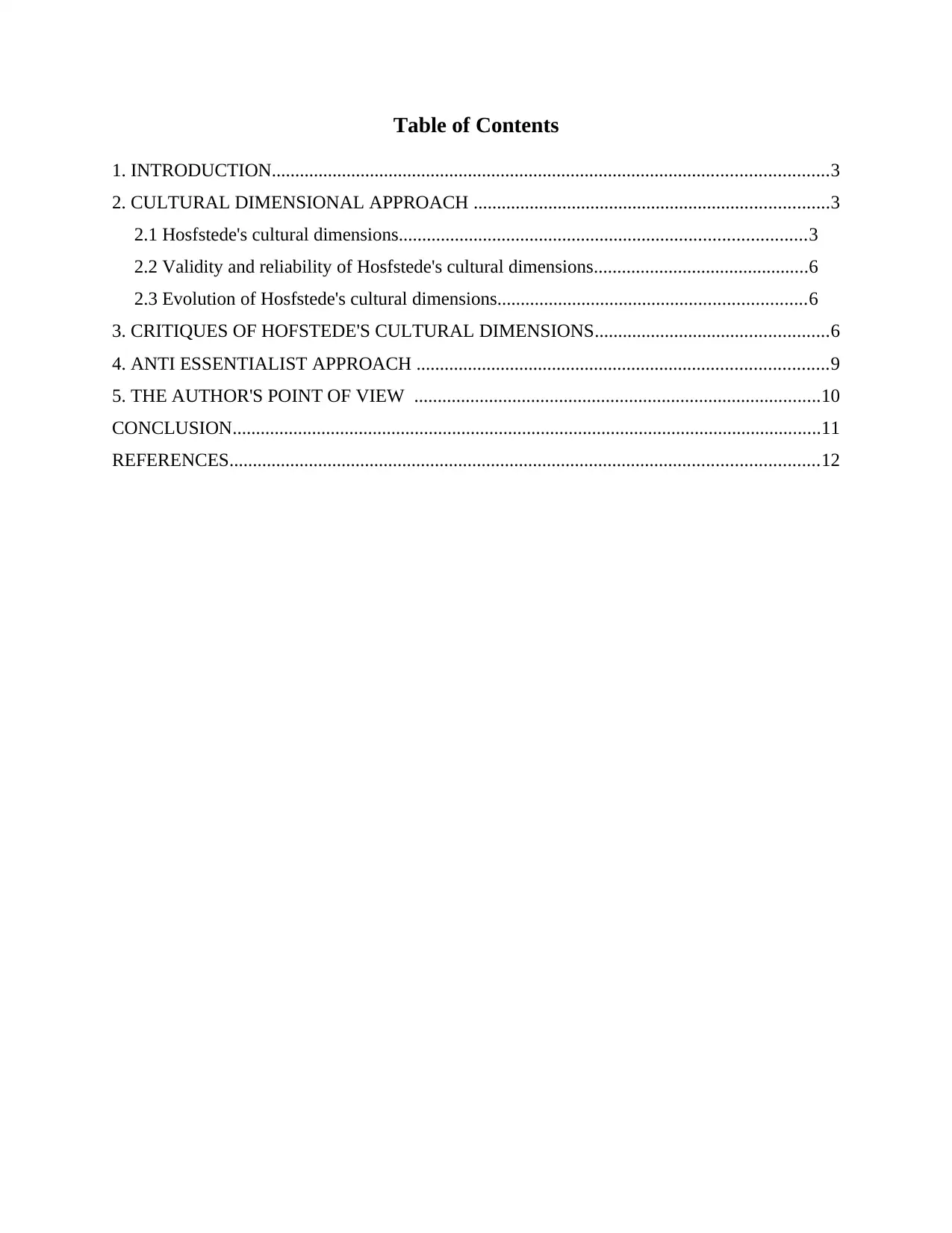
Table of Contents
1. INTRODUCTION.......................................................................................................................3
2. CULTURAL DIMENSIONAL APPROACH ............................................................................3
2.1 Hosfstede's cultural dimensions.......................................................................................3
2.2 Validity and reliability of Hosfstede's cultural dimensions..............................................6
2.3 Evolution of Hosfstede's cultural dimensions..................................................................6
3. CRITIQUES OF HOFSTEDE'S CULTURAL DIMENSIONS..................................................6
4. ANTI ESSENTIALIST APPROACH ........................................................................................9
5. THE AUTHOR'S POINT OF VIEW .......................................................................................10
CONCLUSION..............................................................................................................................11
REFERENCES..............................................................................................................................12
1. INTRODUCTION.......................................................................................................................3
2. CULTURAL DIMENSIONAL APPROACH ............................................................................3
2.1 Hosfstede's cultural dimensions.......................................................................................3
2.2 Validity and reliability of Hosfstede's cultural dimensions..............................................6
2.3 Evolution of Hosfstede's cultural dimensions..................................................................6
3. CRITIQUES OF HOFSTEDE'S CULTURAL DIMENSIONS..................................................6
4. ANTI ESSENTIALIST APPROACH ........................................................................................9
5. THE AUTHOR'S POINT OF VIEW .......................................................................................10
CONCLUSION..............................................................................................................................11
REFERENCES..............................................................................................................................12

1. INTRODUCTION
Intercultural business communication deals with study of communication within
intercultural as well as cross-cultural business contexts. Within global economy as well as world
commerce intercultural business communication play key role within global business partners as
well as customer (Pikhart, 2017). Apart from this, cross-cultural communication also related to
the attempts which made for exchange, negotiate as well as mediate cultural difference by means
of gestures, body language and so on. Thus, simply it is how people of different culture
communicate with each other. This report is based on cultural dimensional approach and anti-
essentialist argument in context of cultural complexness. For proper explanation to this entire
framework Hofstede's cross cultural model will be explained. Along with this, critical discuss of
respective cross cultural model will take place including discussion on anti-essentialist belief of
“cultural complexity”.
2. CULTURAL DIMENSIONAL APPROACH
2.1 Hosfstede's cultural dimensions
Cross cultural communication is related to communication which take place within two
people who are different from each other in following manner such as age, nationality, working
style, ethnicity, rage,sexual orientation, gender and many more. In simple term, cross-cultural
communication also related to the attempts which made for exchange, negotiate as well as
mediate cultural difference by means of gestures, body language and so on. Thus, simply it is
how people of different culture communicate with each other.
In simple term it can be said that, Hosfstede's cultural dimensions framework use for
differentiate in different national cultures, dimensions of culture as well as their effect on
enterprise setting (Casmir, 2013). Main aim behind conducting this study is to determine the
dimensions within that society change. In addition to this, it is necessary to understand host
country's culture because domestic is not enough as global market is changing fast and result in
increasing level of competition. There are six categories within Hofstede model which define
culture explanation of these are as follows :-
Intercultural business communication deals with study of communication within
intercultural as well as cross-cultural business contexts. Within global economy as well as world
commerce intercultural business communication play key role within global business partners as
well as customer (Pikhart, 2017). Apart from this, cross-cultural communication also related to
the attempts which made for exchange, negotiate as well as mediate cultural difference by means
of gestures, body language and so on. Thus, simply it is how people of different culture
communicate with each other. This report is based on cultural dimensional approach and anti-
essentialist argument in context of cultural complexness. For proper explanation to this entire
framework Hofstede's cross cultural model will be explained. Along with this, critical discuss of
respective cross cultural model will take place including discussion on anti-essentialist belief of
“cultural complexity”.
2. CULTURAL DIMENSIONAL APPROACH
2.1 Hosfstede's cultural dimensions
Cross cultural communication is related to communication which take place within two
people who are different from each other in following manner such as age, nationality, working
style, ethnicity, rage,sexual orientation, gender and many more. In simple term, cross-cultural
communication also related to the attempts which made for exchange, negotiate as well as
mediate cultural difference by means of gestures, body language and so on. Thus, simply it is
how people of different culture communicate with each other.
In simple term it can be said that, Hosfstede's cultural dimensions framework use for
differentiate in different national cultures, dimensions of culture as well as their effect on
enterprise setting (Casmir, 2013). Main aim behind conducting this study is to determine the
dimensions within that society change. In addition to this, it is necessary to understand host
country's culture because domestic is not enough as global market is changing fast and result in
increasing level of competition. There are six categories within Hofstede model which define
culture explanation of these are as follows :-
⊘ This is a preview!⊘
Do you want full access?
Subscribe today to unlock all pages.

Trusted by 1+ million students worldwide
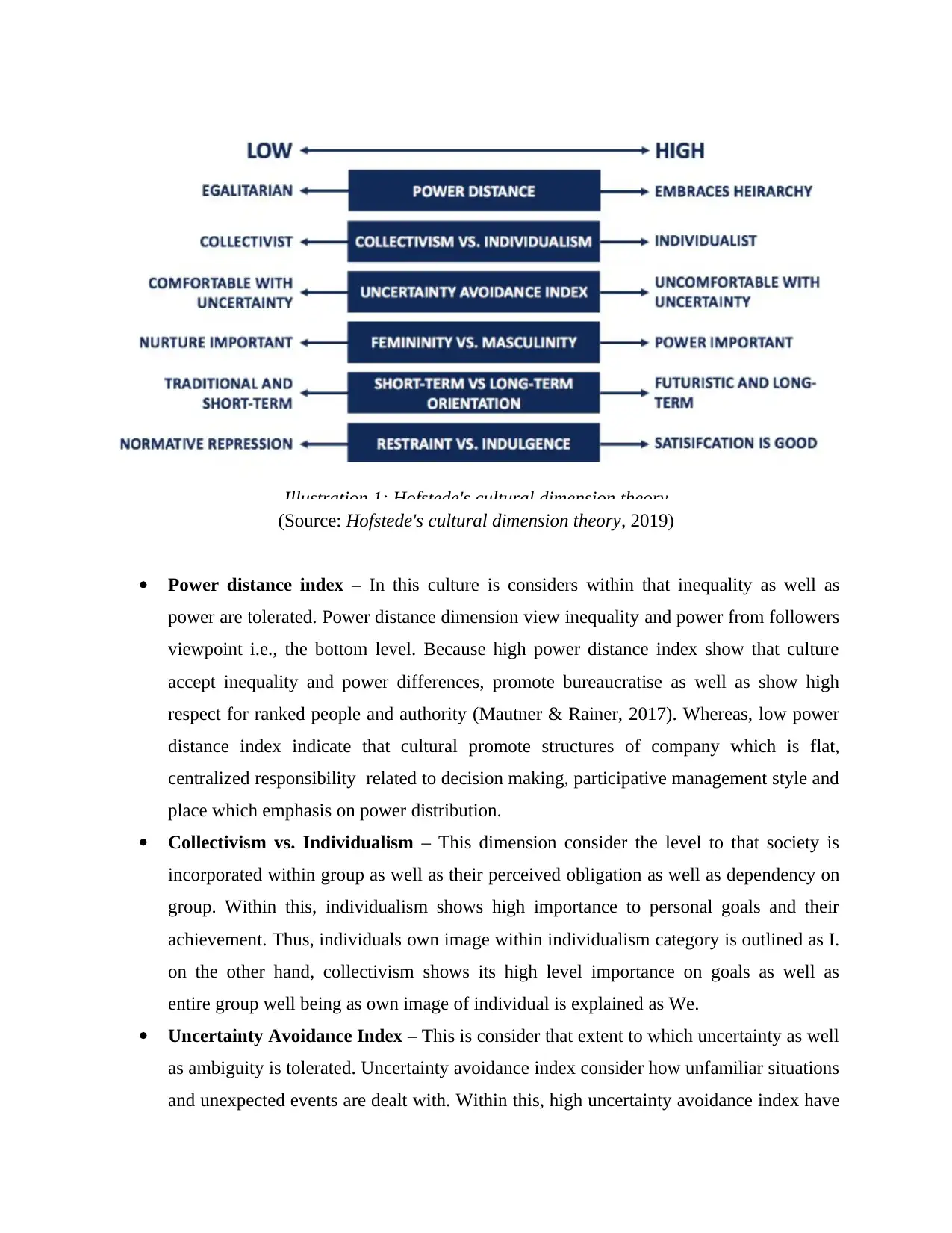
(Source: Hofstede's cultural dimension theory, 2019)
Power distance index – In this culture is considers within that inequality as well as
power are tolerated. Power distance dimension view inequality and power from followers
viewpoint i.e., the bottom level. Because high power distance index show that culture
accept inequality and power differences, promote bureaucratise as well as show high
respect for ranked people and authority (Mautner & Rainer, 2017). Whereas, low power
distance index indicate that cultural promote structures of company which is flat,
centralized responsibility related to decision making, participative management style and
place which emphasis on power distribution.
Collectivism vs. Individualism – This dimension consider the level to that society is
incorporated within group as well as their perceived obligation as well as dependency on
group. Within this, individualism shows high importance to personal goals and their
achievement. Thus, individuals own image within individualism category is outlined as I.
on the other hand, collectivism shows its high level importance on goals as well as
entire group well being as own image of individual is explained as We.
Uncertainty Avoidance Index – This is consider that extent to which uncertainty as well
as ambiguity is tolerated. Uncertainty avoidance index consider how unfamiliar situations
and unexpected events are dealt with. Within this, high uncertainty avoidance index have
Illustration 1: Hofstede's cultural dimension theory
Power distance index – In this culture is considers within that inequality as well as
power are tolerated. Power distance dimension view inequality and power from followers
viewpoint i.e., the bottom level. Because high power distance index show that culture
accept inequality and power differences, promote bureaucratise as well as show high
respect for ranked people and authority (Mautner & Rainer, 2017). Whereas, low power
distance index indicate that cultural promote structures of company which is flat,
centralized responsibility related to decision making, participative management style and
place which emphasis on power distribution.
Collectivism vs. Individualism – This dimension consider the level to that society is
incorporated within group as well as their perceived obligation as well as dependency on
group. Within this, individualism shows high importance to personal goals and their
achievement. Thus, individuals own image within individualism category is outlined as I.
on the other hand, collectivism shows its high level importance on goals as well as
entire group well being as own image of individual is explained as We.
Uncertainty Avoidance Index – This is consider that extent to which uncertainty as well
as ambiguity is tolerated. Uncertainty avoidance index consider how unfamiliar situations
and unexpected events are dealt with. Within this, high uncertainty avoidance index have
Illustration 1: Hofstede's cultural dimension theory
Paraphrase This Document
Need a fresh take? Get an instant paraphrase of this document with our AI Paraphraser
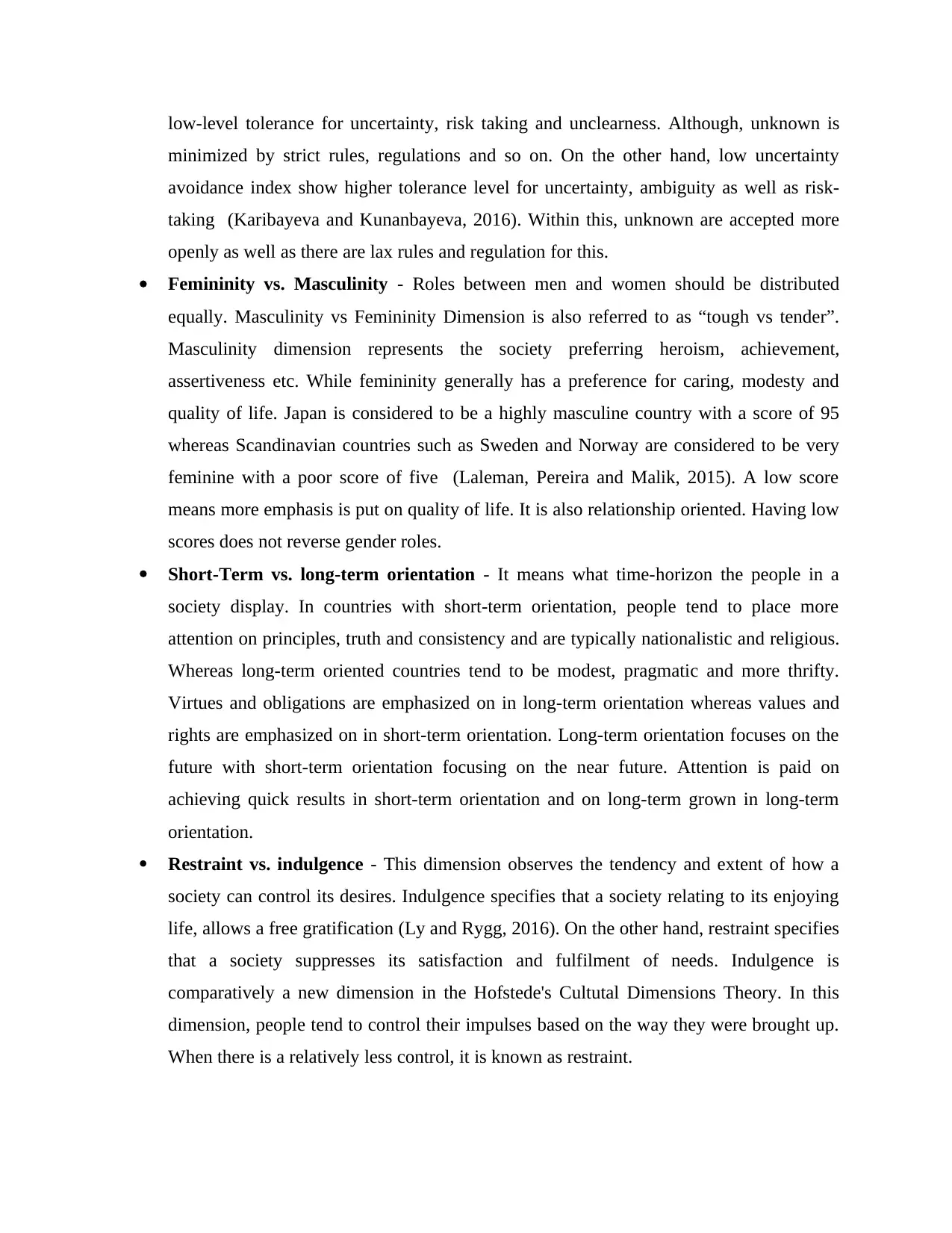
low-level tolerance for uncertainty, risk taking and unclearness. Although, unknown is
minimized by strict rules, regulations and so on. On the other hand, low uncertainty
avoidance index show higher tolerance level for uncertainty, ambiguity as well as risk-
taking (Karibayeva and Kunanbayeva, 2016). Within this, unknown are accepted more
openly as well as there are lax rules and regulation for this.
Femininity vs. Masculinity - Roles between men and women should be distributed
equally. Masculinity vs Femininity Dimension is also referred to as “tough vs tender”.
Masculinity dimension represents the society preferring heroism, achievement,
assertiveness etc. While femininity generally has a preference for caring, modesty and
quality of life. Japan is considered to be a highly masculine country with a score of 95
whereas Scandinavian countries such as Sweden and Norway are considered to be very
feminine with a poor score of five (Laleman, Pereira and Malik, 2015). A low score
means more emphasis is put on quality of life. It is also relationship oriented. Having low
scores does not reverse gender roles.
Short-Term vs. long-term orientation - It means what time-horizon the people in a
society display. In countries with short-term orientation, people tend to place more
attention on principles, truth and consistency and are typically nationalistic and religious.
Whereas long-term oriented countries tend to be modest, pragmatic and more thrifty.
Virtues and obligations are emphasized on in long-term orientation whereas values and
rights are emphasized on in short-term orientation. Long-term orientation focuses on the
future with short-term orientation focusing on the near future. Attention is paid on
achieving quick results in short-term orientation and on long-term grown in long-term
orientation.
Restraint vs. indulgence - This dimension observes the tendency and extent of how a
society can control its desires. Indulgence specifies that a society relating to its enjoying
life, allows a free gratification (Ly and Rygg, 2016). On the other hand, restraint specifies
that a society suppresses its satisfaction and fulfilment of needs. Indulgence is
comparatively a new dimension in the Hofstede's Cultutal Dimensions Theory. In this
dimension, people tend to control their impulses based on the way they were brought up.
When there is a relatively less control, it is known as restraint.
minimized by strict rules, regulations and so on. On the other hand, low uncertainty
avoidance index show higher tolerance level for uncertainty, ambiguity as well as risk-
taking (Karibayeva and Kunanbayeva, 2016). Within this, unknown are accepted more
openly as well as there are lax rules and regulation for this.
Femininity vs. Masculinity - Roles between men and women should be distributed
equally. Masculinity vs Femininity Dimension is also referred to as “tough vs tender”.
Masculinity dimension represents the society preferring heroism, achievement,
assertiveness etc. While femininity generally has a preference for caring, modesty and
quality of life. Japan is considered to be a highly masculine country with a score of 95
whereas Scandinavian countries such as Sweden and Norway are considered to be very
feminine with a poor score of five (Laleman, Pereira and Malik, 2015). A low score
means more emphasis is put on quality of life. It is also relationship oriented. Having low
scores does not reverse gender roles.
Short-Term vs. long-term orientation - It means what time-horizon the people in a
society display. In countries with short-term orientation, people tend to place more
attention on principles, truth and consistency and are typically nationalistic and religious.
Whereas long-term oriented countries tend to be modest, pragmatic and more thrifty.
Virtues and obligations are emphasized on in long-term orientation whereas values and
rights are emphasized on in short-term orientation. Long-term orientation focuses on the
future with short-term orientation focusing on the near future. Attention is paid on
achieving quick results in short-term orientation and on long-term grown in long-term
orientation.
Restraint vs. indulgence - This dimension observes the tendency and extent of how a
society can control its desires. Indulgence specifies that a society relating to its enjoying
life, allows a free gratification (Ly and Rygg, 2016). On the other hand, restraint specifies
that a society suppresses its satisfaction and fulfilment of needs. Indulgence is
comparatively a new dimension in the Hofstede's Cultutal Dimensions Theory. In this
dimension, people tend to control their impulses based on the way they were brought up.
When there is a relatively less control, it is known as restraint.
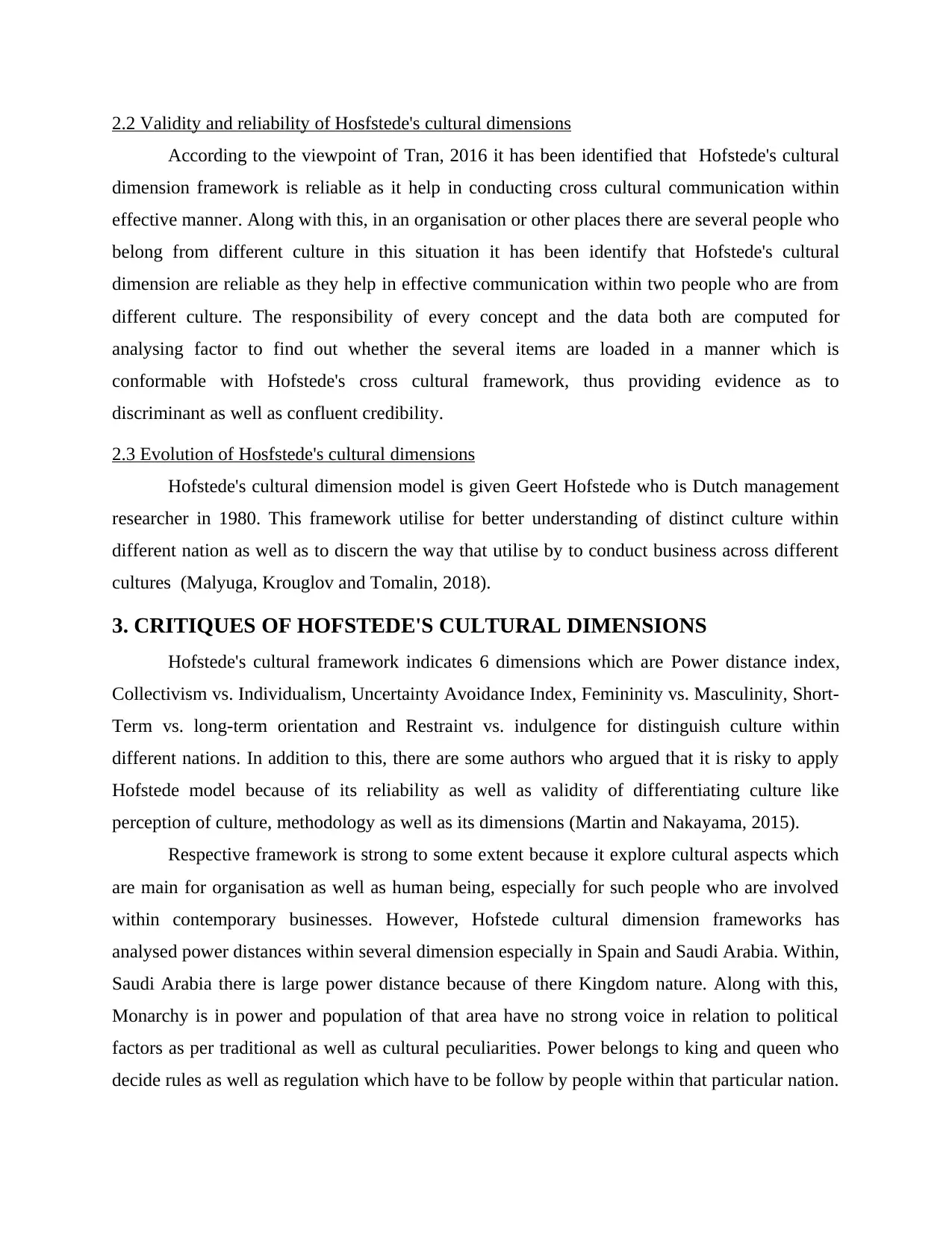
2.2 Validity and reliability of Hosfstede's cultural dimensions
According to the viewpoint of Tran, 2016 it has been identified that Hofstede's cultural
dimension framework is reliable as it help in conducting cross cultural communication within
effective manner. Along with this, in an organisation or other places there are several people who
belong from different culture in this situation it has been identify that Hofstede's cultural
dimension are reliable as they help in effective communication within two people who are from
different culture. The responsibility of every concept and the data both are computed for
analysing factor to find out whether the several items are loaded in a manner which is
conformable with Hofstede's cross cultural framework, thus providing evidence as to
discriminant as well as confluent credibility.
2.3 Evolution of Hosfstede's cultural dimensions
Hofstede's cultural dimension model is given Geert Hofstede who is Dutch management
researcher in 1980. This framework utilise for better understanding of distinct culture within
different nation as well as to discern the way that utilise by to conduct business across different
cultures (Malyuga, Krouglov and Tomalin, 2018).
3. CRITIQUES OF HOFSTEDE'S CULTURAL DIMENSIONS
Hofstede's cultural framework indicates 6 dimensions which are Power distance index,
Collectivism vs. Individualism, Uncertainty Avoidance Index, Femininity vs. Masculinity, Short-
Term vs. long-term orientation and Restraint vs. indulgence for distinguish culture within
different nations. In addition to this, there are some authors who argued that it is risky to apply
Hofstede model because of its reliability as well as validity of differentiating culture like
perception of culture, methodology as well as its dimensions (Martin and Nakayama, 2015).
Respective framework is strong to some extent because it explore cultural aspects which
are main for organisation as well as human being, especially for such people who are involved
within contemporary businesses. However, Hofstede cultural dimension frameworks has
analysed power distances within several dimension especially in Spain and Saudi Arabia. Within,
Saudi Arabia there is large power distance because of there Kingdom nature. Along with this,
Monarchy is in power and population of that area have no strong voice in relation to political
factors as per traditional as well as cultural peculiarities. Power belongs to king and queen who
decide rules as well as regulation which have to be follow by people within that particular nation.
According to the viewpoint of Tran, 2016 it has been identified that Hofstede's cultural
dimension framework is reliable as it help in conducting cross cultural communication within
effective manner. Along with this, in an organisation or other places there are several people who
belong from different culture in this situation it has been identify that Hofstede's cultural
dimension are reliable as they help in effective communication within two people who are from
different culture. The responsibility of every concept and the data both are computed for
analysing factor to find out whether the several items are loaded in a manner which is
conformable with Hofstede's cross cultural framework, thus providing evidence as to
discriminant as well as confluent credibility.
2.3 Evolution of Hosfstede's cultural dimensions
Hofstede's cultural dimension model is given Geert Hofstede who is Dutch management
researcher in 1980. This framework utilise for better understanding of distinct culture within
different nation as well as to discern the way that utilise by to conduct business across different
cultures (Malyuga, Krouglov and Tomalin, 2018).
3. CRITIQUES OF HOFSTEDE'S CULTURAL DIMENSIONS
Hofstede's cultural framework indicates 6 dimensions which are Power distance index,
Collectivism vs. Individualism, Uncertainty Avoidance Index, Femininity vs. Masculinity, Short-
Term vs. long-term orientation and Restraint vs. indulgence for distinguish culture within
different nations. In addition to this, there are some authors who argued that it is risky to apply
Hofstede model because of its reliability as well as validity of differentiating culture like
perception of culture, methodology as well as its dimensions (Martin and Nakayama, 2015).
Respective framework is strong to some extent because it explore cultural aspects which
are main for organisation as well as human being, especially for such people who are involved
within contemporary businesses. However, Hofstede cultural dimension frameworks has
analysed power distances within several dimension especially in Spain and Saudi Arabia. Within,
Saudi Arabia there is large power distance because of there Kingdom nature. Along with this,
Monarchy is in power and population of that area have no strong voice in relation to political
factors as per traditional as well as cultural peculiarities. Power belongs to king and queen who
decide rules as well as regulation which have to be follow by people within that particular nation.
⊘ This is a preview!⊘
Do you want full access?
Subscribe today to unlock all pages.

Trusted by 1+ million students worldwide
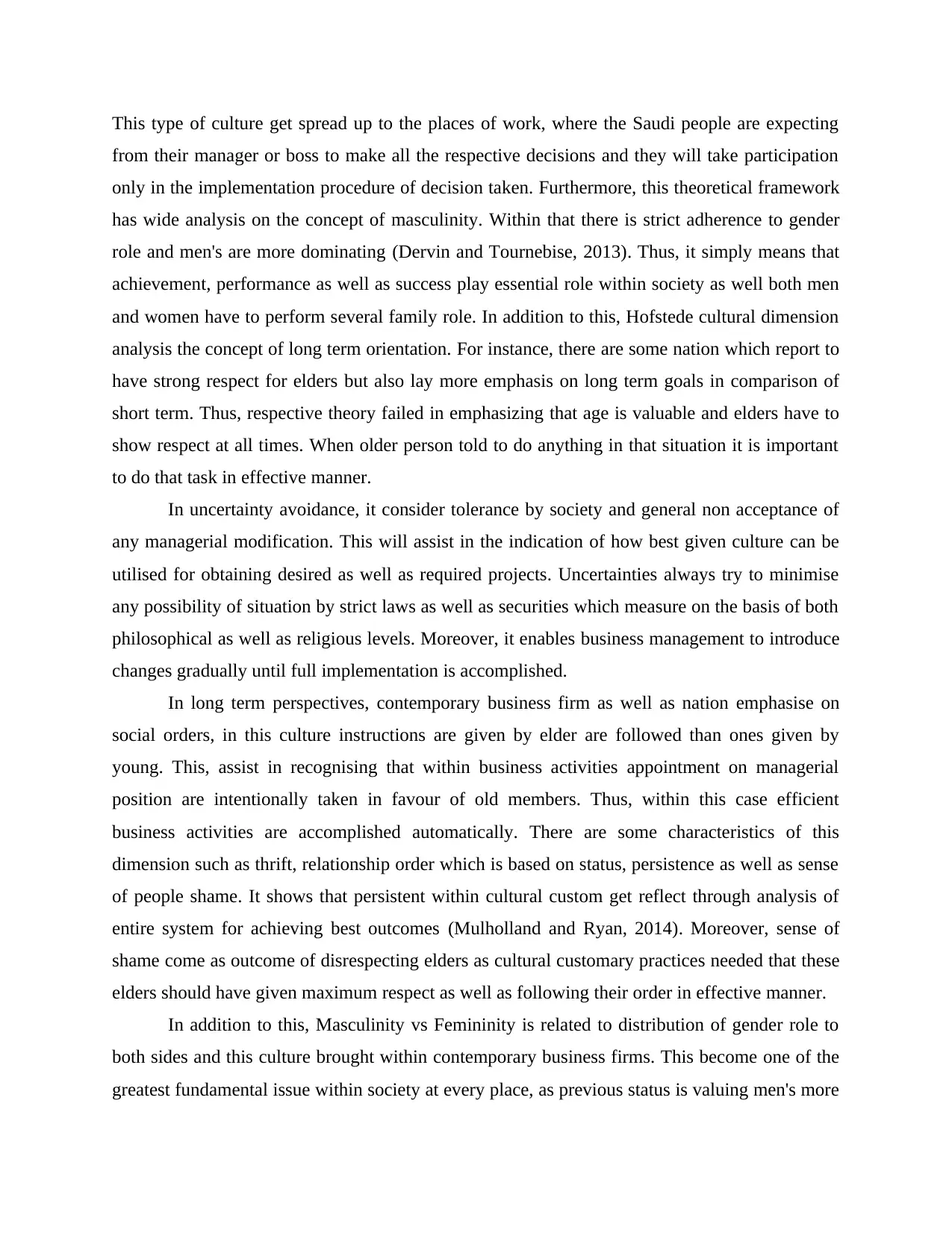
This type of culture get spread up to the places of work, where the Saudi people are expecting
from their manager or boss to make all the respective decisions and they will take participation
only in the implementation procedure of decision taken. Furthermore, this theoretical framework
has wide analysis on the concept of masculinity. Within that there is strict adherence to gender
role and men's are more dominating (Dervin and Tournebise, 2013). Thus, it simply means that
achievement, performance as well as success play essential role within society as well both men
and women have to perform several family role. In addition to this, Hofstede cultural dimension
analysis the concept of long term orientation. For instance, there are some nation which report to
have strong respect for elders but also lay more emphasis on long term goals in comparison of
short term. Thus, respective theory failed in emphasizing that age is valuable and elders have to
show respect at all times. When older person told to do anything in that situation it is important
to do that task in effective manner.
In uncertainty avoidance, it consider tolerance by society and general non acceptance of
any managerial modification. This will assist in the indication of how best given culture can be
utilised for obtaining desired as well as required projects. Uncertainties always try to minimise
any possibility of situation by strict laws as well as securities which measure on the basis of both
philosophical as well as religious levels. Moreover, it enables business management to introduce
changes gradually until full implementation is accomplished.
In long term perspectives, contemporary business firm as well as nation emphasise on
social orders, in this culture instructions are given by elder are followed than ones given by
young. This, assist in recognising that within business activities appointment on managerial
position are intentionally taken in favour of old members. Thus, within this case efficient
business activities are accomplished automatically. There are some characteristics of this
dimension such as thrift, relationship order which is based on status, persistence as well as sense
of people shame. It shows that persistent within cultural custom get reflect through analysis of
entire system for achieving best outcomes (Mulholland and Ryan, 2014). Moreover, sense of
shame come as outcome of disrespecting elders as cultural customary practices needed that these
elders should have given maximum respect as well as following their order in effective manner.
In addition to this, Masculinity vs Femininity is related to distribution of gender role to
both sides and this culture brought within contemporary business firms. This become one of the
greatest fundamental issue within society at every place, as previous status is valuing men's more
from their manager or boss to make all the respective decisions and they will take participation
only in the implementation procedure of decision taken. Furthermore, this theoretical framework
has wide analysis on the concept of masculinity. Within that there is strict adherence to gender
role and men's are more dominating (Dervin and Tournebise, 2013). Thus, it simply means that
achievement, performance as well as success play essential role within society as well both men
and women have to perform several family role. In addition to this, Hofstede cultural dimension
analysis the concept of long term orientation. For instance, there are some nation which report to
have strong respect for elders but also lay more emphasis on long term goals in comparison of
short term. Thus, respective theory failed in emphasizing that age is valuable and elders have to
show respect at all times. When older person told to do anything in that situation it is important
to do that task in effective manner.
In uncertainty avoidance, it consider tolerance by society and general non acceptance of
any managerial modification. This will assist in the indication of how best given culture can be
utilised for obtaining desired as well as required projects. Uncertainties always try to minimise
any possibility of situation by strict laws as well as securities which measure on the basis of both
philosophical as well as religious levels. Moreover, it enables business management to introduce
changes gradually until full implementation is accomplished.
In long term perspectives, contemporary business firm as well as nation emphasise on
social orders, in this culture instructions are given by elder are followed than ones given by
young. This, assist in recognising that within business activities appointment on managerial
position are intentionally taken in favour of old members. Thus, within this case efficient
business activities are accomplished automatically. There are some characteristics of this
dimension such as thrift, relationship order which is based on status, persistence as well as sense
of people shame. It shows that persistent within cultural custom get reflect through analysis of
entire system for achieving best outcomes (Mulholland and Ryan, 2014). Moreover, sense of
shame come as outcome of disrespecting elders as cultural customary practices needed that these
elders should have given maximum respect as well as following their order in effective manner.
In addition to this, Masculinity vs Femininity is related to distribution of gender role to
both sides and this culture brought within contemporary business firms. This become one of the
greatest fundamental issue within society at every place, as previous status is valuing men's more
Paraphrase This Document
Need a fresh take? Get an instant paraphrase of this document with our AI Paraphraser

in comparison of women's (PM, 2016). Within business environment also masculinity is
favoured more in comparison of femininity. But such things are recreation in-equal opportunities
for men's and women's by differentiating them on the basis of gender. Apart from this,
individualism and collectivism measures the level within that individual are integrated within
given societal group. Within contemporary business firm staff share their responsibilities with
others which shows that organisation have collectivism culture. Thus, responsibilities and
belongings are based on group influence but not on individual perspectives. In contemporary
business firm, this measurement have to be applied in accurate manner, because these people
value culture as well as collectivism with higher responsibility (Popescu, 2013). Thus,
Hofstede’s scale is a good reflection of cultural collective grouping which should be enhanced by
business organisations.
Hofstede's frameworks on power distance index is measure an extent to that less powerful
member of company and family institutions accept as well as expect how power is not
distributed equally. This respective inequality index where have more in comparison of less as
well as level of inequality is mostly supported through its leaders and followers. This became
case within contemporary business organisation or nation culture in which society is favouring
imbalance because of assumptions related to powers by leaders. Moreover, leaders as well as
other common people believe that there should be some gap within them. Thus, such practices
result in raising inequality index.
Thus, it become essential to manage cross-cultural for gaining importance as well as it
also become important to understand cultural difference as it become essential (Nickerson and
Planken, 2015). Moreover, global market is changing faster which result in increasing
international competition and it become essential for manager to understand both culture of
domestic as well as host country.
Cultural complexity is most common variable used in cross-cultural research. It is utilise
as measure of cultural evolution and shown to correlate with several other variables. There are
four distinct level of culture explanation of these are as follows ;-
The core level is human culture – Each and every individual share human culture which
include emotional, physical, intellectual, spiritual capacities and many more (Victor,
2012). All these make possible to understand the level of grief as well as joy which has
been founded across language barriers.
favoured more in comparison of femininity. But such things are recreation in-equal opportunities
for men's and women's by differentiating them on the basis of gender. Apart from this,
individualism and collectivism measures the level within that individual are integrated within
given societal group. Within contemporary business firm staff share their responsibilities with
others which shows that organisation have collectivism culture. Thus, responsibilities and
belongings are based on group influence but not on individual perspectives. In contemporary
business firm, this measurement have to be applied in accurate manner, because these people
value culture as well as collectivism with higher responsibility (Popescu, 2013). Thus,
Hofstede’s scale is a good reflection of cultural collective grouping which should be enhanced by
business organisations.
Hofstede's frameworks on power distance index is measure an extent to that less powerful
member of company and family institutions accept as well as expect how power is not
distributed equally. This respective inequality index where have more in comparison of less as
well as level of inequality is mostly supported through its leaders and followers. This became
case within contemporary business organisation or nation culture in which society is favouring
imbalance because of assumptions related to powers by leaders. Moreover, leaders as well as
other common people believe that there should be some gap within them. Thus, such practices
result in raising inequality index.
Thus, it become essential to manage cross-cultural for gaining importance as well as it
also become important to understand cultural difference as it become essential (Nickerson and
Planken, 2015). Moreover, global market is changing faster which result in increasing
international competition and it become essential for manager to understand both culture of
domestic as well as host country.
Cultural complexity is most common variable used in cross-cultural research. It is utilise
as measure of cultural evolution and shown to correlate with several other variables. There are
four distinct level of culture explanation of these are as follows ;-
The core level is human culture – Each and every individual share human culture which
include emotional, physical, intellectual, spiritual capacities and many more (Victor,
2012). All these make possible to understand the level of grief as well as joy which has
been founded across language barriers.
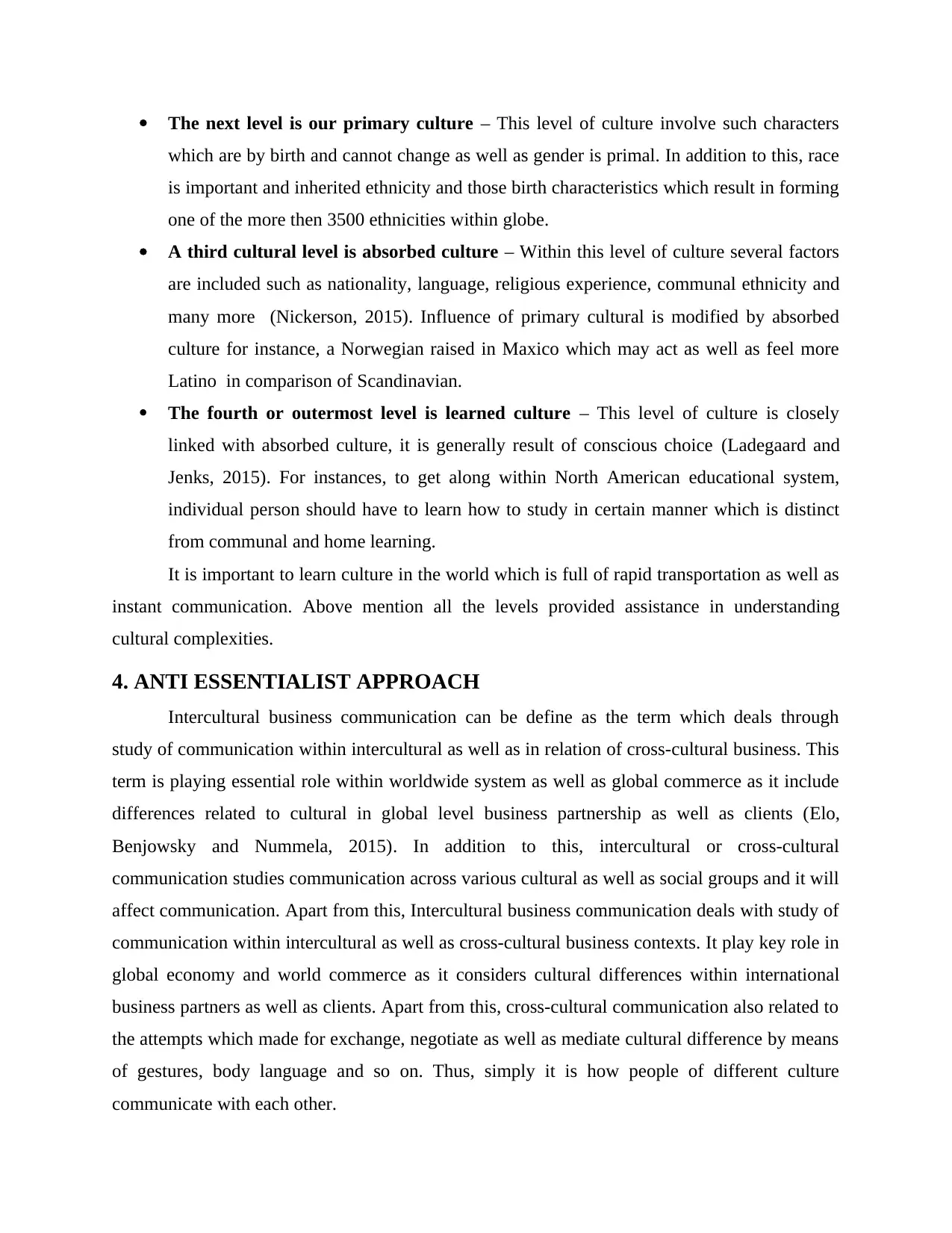
The next level is our primary culture – This level of culture involve such characters
which are by birth and cannot change as well as gender is primal. In addition to this, race
is important and inherited ethnicity and those birth characteristics which result in forming
one of the more then 3500 ethnicities within globe.
A third cultural level is absorbed culture – Within this level of culture several factors
are included such as nationality, language, religious experience, communal ethnicity and
many more (Nickerson, 2015). Influence of primary cultural is modified by absorbed
culture for instance, a Norwegian raised in Maxico which may act as well as feel more
Latino in comparison of Scandinavian.
The fourth or outermost level is learned culture – This level of culture is closely
linked with absorbed culture, it is generally result of conscious choice (Ladegaard and
Jenks, 2015). For instances, to get along within North American educational system,
individual person should have to learn how to study in certain manner which is distinct
from communal and home learning.
It is important to learn culture in the world which is full of rapid transportation as well as
instant communication. Above mention all the levels provided assistance in understanding
cultural complexities.
4. ANTI ESSENTIALIST APPROACH
Intercultural business communication can be define as the term which deals through
study of communication within intercultural as well as in relation of cross-cultural business. This
term is playing essential role within worldwide system as well as global commerce as it include
differences related to cultural in global level business partnership as well as clients (Elo,
Benjowsky and Nummela, 2015). In addition to this, intercultural or cross-cultural
communication studies communication across various cultural as well as social groups and it will
affect communication. Apart from this, Intercultural business communication deals with study of
communication within intercultural as well as cross-cultural business contexts. It play key role in
global economy and world commerce as it considers cultural differences within international
business partners as well as clients. Apart from this, cross-cultural communication also related to
the attempts which made for exchange, negotiate as well as mediate cultural difference by means
of gestures, body language and so on. Thus, simply it is how people of different culture
communicate with each other.
which are by birth and cannot change as well as gender is primal. In addition to this, race
is important and inherited ethnicity and those birth characteristics which result in forming
one of the more then 3500 ethnicities within globe.
A third cultural level is absorbed culture – Within this level of culture several factors
are included such as nationality, language, religious experience, communal ethnicity and
many more (Nickerson, 2015). Influence of primary cultural is modified by absorbed
culture for instance, a Norwegian raised in Maxico which may act as well as feel more
Latino in comparison of Scandinavian.
The fourth or outermost level is learned culture – This level of culture is closely
linked with absorbed culture, it is generally result of conscious choice (Ladegaard and
Jenks, 2015). For instances, to get along within North American educational system,
individual person should have to learn how to study in certain manner which is distinct
from communal and home learning.
It is important to learn culture in the world which is full of rapid transportation as well as
instant communication. Above mention all the levels provided assistance in understanding
cultural complexities.
4. ANTI ESSENTIALIST APPROACH
Intercultural business communication can be define as the term which deals through
study of communication within intercultural as well as in relation of cross-cultural business. This
term is playing essential role within worldwide system as well as global commerce as it include
differences related to cultural in global level business partnership as well as clients (Elo,
Benjowsky and Nummela, 2015). In addition to this, intercultural or cross-cultural
communication studies communication across various cultural as well as social groups and it will
affect communication. Apart from this, Intercultural business communication deals with study of
communication within intercultural as well as cross-cultural business contexts. It play key role in
global economy and world commerce as it considers cultural differences within international
business partners as well as clients. Apart from this, cross-cultural communication also related to
the attempts which made for exchange, negotiate as well as mediate cultural difference by means
of gestures, body language and so on. Thus, simply it is how people of different culture
communicate with each other.
⊘ This is a preview!⊘
Do you want full access?
Subscribe today to unlock all pages.

Trusted by 1+ million students worldwide
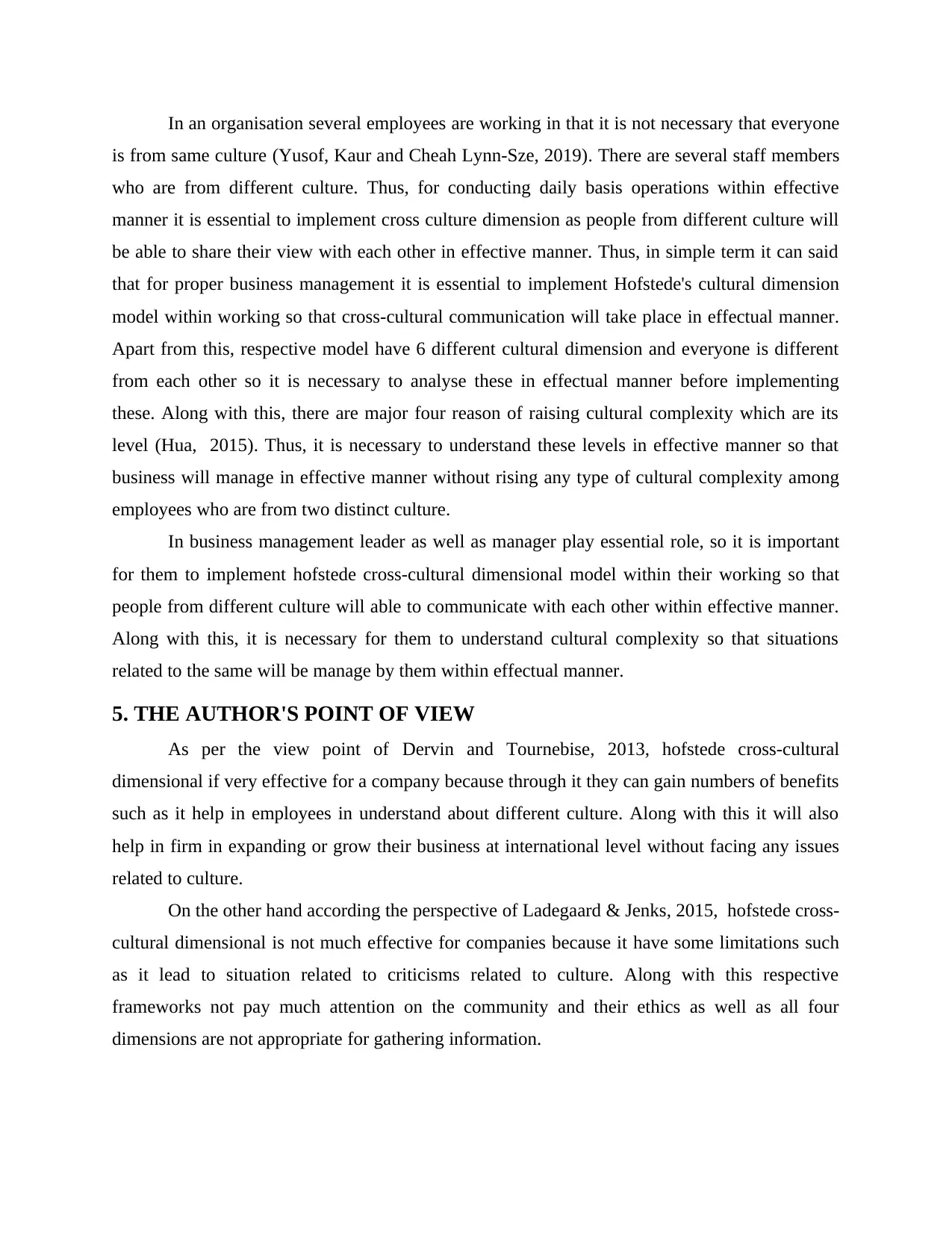
In an organisation several employees are working in that it is not necessary that everyone
is from same culture (Yusof, Kaur and Cheah Lynn-Sze, 2019). There are several staff members
who are from different culture. Thus, for conducting daily basis operations within effective
manner it is essential to implement cross culture dimension as people from different culture will
be able to share their view with each other in effective manner. Thus, in simple term it can said
that for proper business management it is essential to implement Hofstede's cultural dimension
model within working so that cross-cultural communication will take place in effectual manner.
Apart from this, respective model have 6 different cultural dimension and everyone is different
from each other so it is necessary to analyse these in effectual manner before implementing
these. Along with this, there are major four reason of raising cultural complexity which are its
level (Hua, 2015). Thus, it is necessary to understand these levels in effective manner so that
business will manage in effective manner without rising any type of cultural complexity among
employees who are from two distinct culture.
In business management leader as well as manager play essential role, so it is important
for them to implement hofstede cross-cultural dimensional model within their working so that
people from different culture will able to communicate with each other within effective manner.
Along with this, it is necessary for them to understand cultural complexity so that situations
related to the same will be manage by them within effectual manner.
5. THE AUTHOR'S POINT OF VIEW
As per the view point of Dervin and Tournebise, 2013, hofstede cross-cultural
dimensional if very effective for a company because through it they can gain numbers of benefits
such as it help in employees in understand about different culture. Along with this it will also
help in firm in expanding or grow their business at international level without facing any issues
related to culture.
On the other hand according the perspective of Ladegaard & Jenks, 2015, hofstede cross-
cultural dimensional is not much effective for companies because it have some limitations such
as it lead to situation related to criticisms related to culture. Along with this respective
frameworks not pay much attention on the community and their ethics as well as all four
dimensions are not appropriate for gathering information.
is from same culture (Yusof, Kaur and Cheah Lynn-Sze, 2019). There are several staff members
who are from different culture. Thus, for conducting daily basis operations within effective
manner it is essential to implement cross culture dimension as people from different culture will
be able to share their view with each other in effective manner. Thus, in simple term it can said
that for proper business management it is essential to implement Hofstede's cultural dimension
model within working so that cross-cultural communication will take place in effectual manner.
Apart from this, respective model have 6 different cultural dimension and everyone is different
from each other so it is necessary to analyse these in effectual manner before implementing
these. Along with this, there are major four reason of raising cultural complexity which are its
level (Hua, 2015). Thus, it is necessary to understand these levels in effective manner so that
business will manage in effective manner without rising any type of cultural complexity among
employees who are from two distinct culture.
In business management leader as well as manager play essential role, so it is important
for them to implement hofstede cross-cultural dimensional model within their working so that
people from different culture will able to communicate with each other within effective manner.
Along with this, it is necessary for them to understand cultural complexity so that situations
related to the same will be manage by them within effectual manner.
5. THE AUTHOR'S POINT OF VIEW
As per the view point of Dervin and Tournebise, 2013, hofstede cross-cultural
dimensional if very effective for a company because through it they can gain numbers of benefits
such as it help in employees in understand about different culture. Along with this it will also
help in firm in expanding or grow their business at international level without facing any issues
related to culture.
On the other hand according the perspective of Ladegaard & Jenks, 2015, hofstede cross-
cultural dimensional is not much effective for companies because it have some limitations such
as it lead to situation related to criticisms related to culture. Along with this respective
frameworks not pay much attention on the community and their ethics as well as all four
dimensions are not appropriate for gathering information.
Paraphrase This Document
Need a fresh take? Get an instant paraphrase of this document with our AI Paraphraser
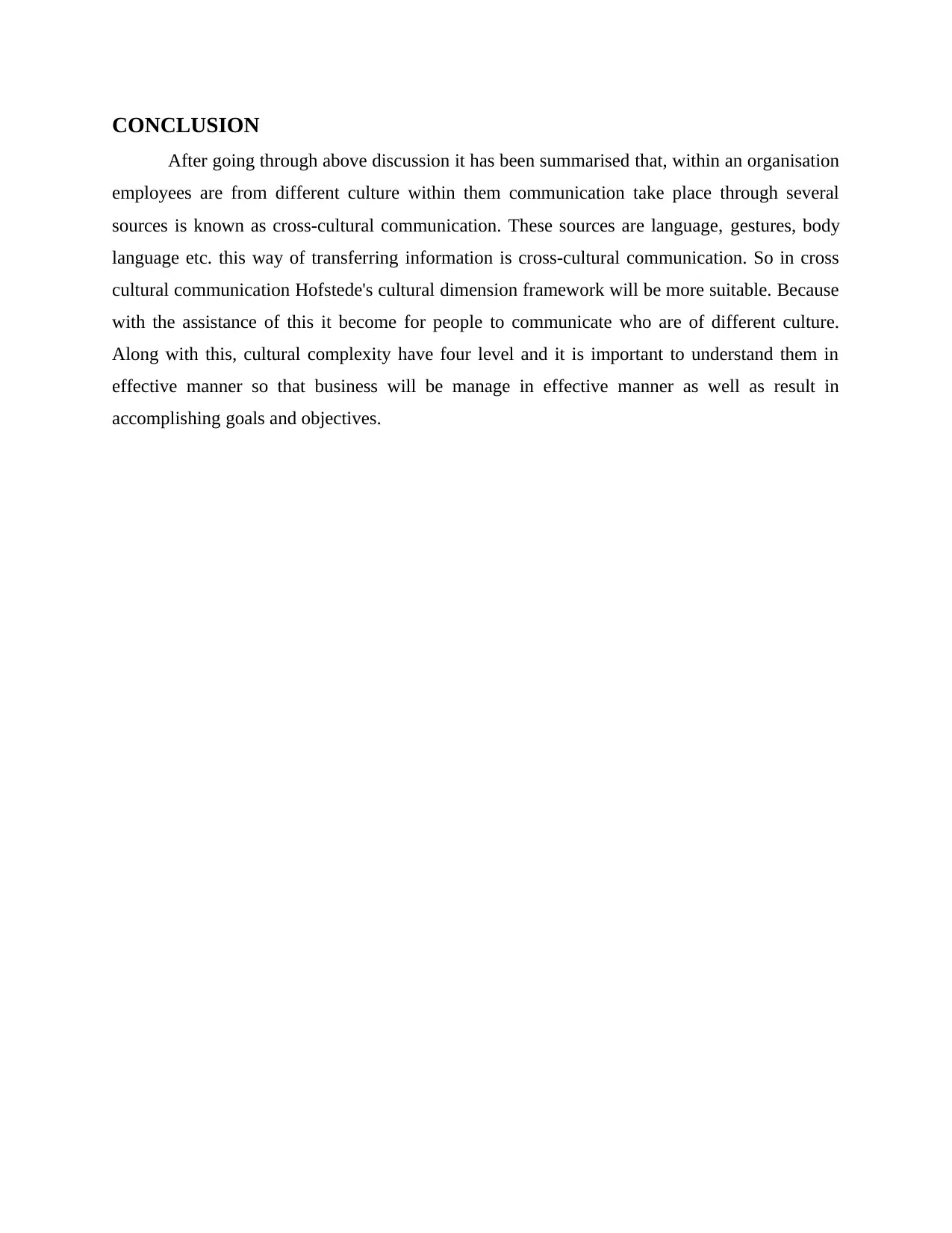
CONCLUSION
After going through above discussion it has been summarised that, within an organisation
employees are from different culture within them communication take place through several
sources is known as cross-cultural communication. These sources are language, gestures, body
language etc. this way of transferring information is cross-cultural communication. So in cross
cultural communication Hofstede's cultural dimension framework will be more suitable. Because
with the assistance of this it become for people to communicate who are of different culture.
Along with this, cultural complexity have four level and it is important to understand them in
effective manner so that business will be manage in effective manner as well as result in
accomplishing goals and objectives.
After going through above discussion it has been summarised that, within an organisation
employees are from different culture within them communication take place through several
sources is known as cross-cultural communication. These sources are language, gestures, body
language etc. this way of transferring information is cross-cultural communication. So in cross
cultural communication Hofstede's cultural dimension framework will be more suitable. Because
with the assistance of this it become for people to communicate who are of different culture.
Along with this, cultural complexity have four level and it is important to understand them in
effective manner so that business will be manage in effective manner as well as result in
accomplishing goals and objectives.
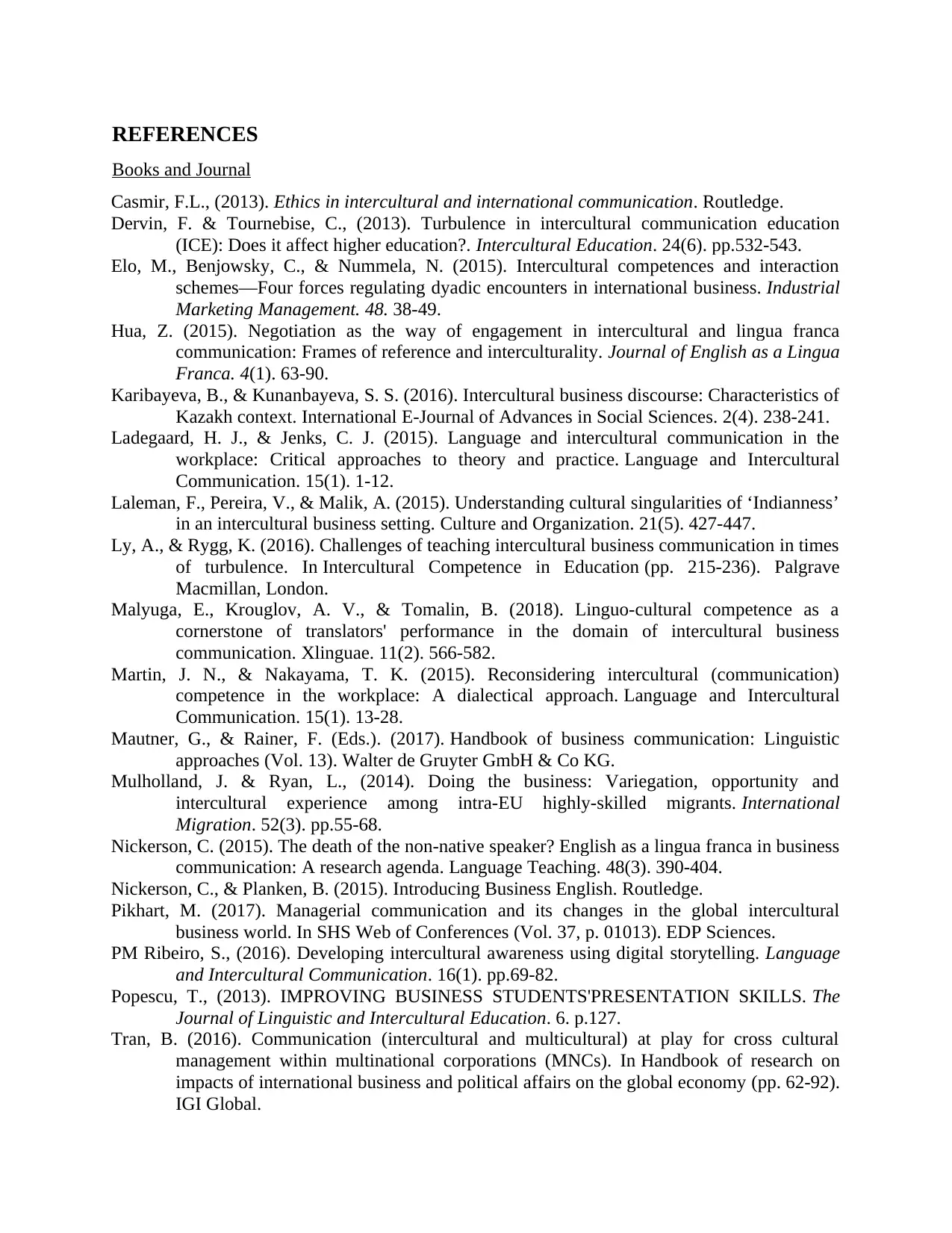
REFERENCES
Books and Journal
Casmir, F.L., (2013). Ethics in intercultural and international communication. Routledge.
Dervin, F. & Tournebise, C., (2013). Turbulence in intercultural communication education
(ICE): Does it affect higher education?. Intercultural Education. 24(6). pp.532-543.
Elo, M., Benjowsky, C., & Nummela, N. (2015). Intercultural competences and interaction
schemes—Four forces regulating dyadic encounters in international business. Industrial
Marketing Management. 48. 38-49.
Hua, Z. (2015). Negotiation as the way of engagement in intercultural and lingua franca
communication: Frames of reference and interculturality. Journal of English as a Lingua
Franca. 4(1). 63-90.
Karibayeva, B., & Kunanbayeva, S. S. (2016). Intercultural business discourse: Characteristics of
Kazakh context. International E-Journal of Advances in Social Sciences. 2(4). 238-241.
Ladegaard, H. J., & Jenks, C. J. (2015). Language and intercultural communication in the
workplace: Critical approaches to theory and practice. Language and Intercultural
Communication. 15(1). 1-12.
Laleman, F., Pereira, V., & Malik, A. (2015). Understanding cultural singularities of ‘Indianness’
in an intercultural business setting. Culture and Organization. 21(5). 427-447.
Ly, A., & Rygg, K. (2016). Challenges of teaching intercultural business communication in times
of turbulence. In Intercultural Competence in Education (pp. 215-236). Palgrave
Macmillan, London.
Malyuga, E., Krouglov, A. V., & Tomalin, B. (2018). Linguo-cultural competence as a
cornerstone of translators' performance in the domain of intercultural business
communication. Xlinguae. 11(2). 566-582.
Martin, J. N., & Nakayama, T. K. (2015). Reconsidering intercultural (communication)
competence in the workplace: A dialectical approach. Language and Intercultural
Communication. 15(1). 13-28.
Mautner, G., & Rainer, F. (Eds.). (2017). Handbook of business communication: Linguistic
approaches (Vol. 13). Walter de Gruyter GmbH & Co KG.
Mulholland, J. & Ryan, L., (2014). Doing the business: Variegation, opportunity and
intercultural experience among intra‐EU highly‐skilled migrants. International
Migration. 52(3). pp.55-68.
Nickerson, C. (2015). The death of the non-native speaker? English as a lingua franca in business
communication: A research agenda. Language Teaching. 48(3). 390-404.
Nickerson, C., & Planken, B. (2015). Introducing Business English. Routledge.
Pikhart, M. (2017). Managerial communication and its changes in the global intercultural
business world. In SHS Web of Conferences (Vol. 37, p. 01013). EDP Sciences.
PM Ribeiro, S., (2016). Developing intercultural awareness using digital storytelling. Language
and Intercultural Communication. 16(1). pp.69-82.
Popescu, T., (2013). IMPROVING BUSINESS STUDENTS'PRESENTATION SKILLS. The
Journal of Linguistic and Intercultural Education. 6. p.127.
Tran, B. (2016). Communication (intercultural and multicultural) at play for cross cultural
management within multinational corporations (MNCs). In Handbook of research on
impacts of international business and political affairs on the global economy (pp. 62-92).
IGI Global.
Books and Journal
Casmir, F.L., (2013). Ethics in intercultural and international communication. Routledge.
Dervin, F. & Tournebise, C., (2013). Turbulence in intercultural communication education
(ICE): Does it affect higher education?. Intercultural Education. 24(6). pp.532-543.
Elo, M., Benjowsky, C., & Nummela, N. (2015). Intercultural competences and interaction
schemes—Four forces regulating dyadic encounters in international business. Industrial
Marketing Management. 48. 38-49.
Hua, Z. (2015). Negotiation as the way of engagement in intercultural and lingua franca
communication: Frames of reference and interculturality. Journal of English as a Lingua
Franca. 4(1). 63-90.
Karibayeva, B., & Kunanbayeva, S. S. (2016). Intercultural business discourse: Characteristics of
Kazakh context. International E-Journal of Advances in Social Sciences. 2(4). 238-241.
Ladegaard, H. J., & Jenks, C. J. (2015). Language and intercultural communication in the
workplace: Critical approaches to theory and practice. Language and Intercultural
Communication. 15(1). 1-12.
Laleman, F., Pereira, V., & Malik, A. (2015). Understanding cultural singularities of ‘Indianness’
in an intercultural business setting. Culture and Organization. 21(5). 427-447.
Ly, A., & Rygg, K. (2016). Challenges of teaching intercultural business communication in times
of turbulence. In Intercultural Competence in Education (pp. 215-236). Palgrave
Macmillan, London.
Malyuga, E., Krouglov, A. V., & Tomalin, B. (2018). Linguo-cultural competence as a
cornerstone of translators' performance in the domain of intercultural business
communication. Xlinguae. 11(2). 566-582.
Martin, J. N., & Nakayama, T. K. (2015). Reconsidering intercultural (communication)
competence in the workplace: A dialectical approach. Language and Intercultural
Communication. 15(1). 13-28.
Mautner, G., & Rainer, F. (Eds.). (2017). Handbook of business communication: Linguistic
approaches (Vol. 13). Walter de Gruyter GmbH & Co KG.
Mulholland, J. & Ryan, L., (2014). Doing the business: Variegation, opportunity and
intercultural experience among intra‐EU highly‐skilled migrants. International
Migration. 52(3). pp.55-68.
Nickerson, C. (2015). The death of the non-native speaker? English as a lingua franca in business
communication: A research agenda. Language Teaching. 48(3). 390-404.
Nickerson, C., & Planken, B. (2015). Introducing Business English. Routledge.
Pikhart, M. (2017). Managerial communication and its changes in the global intercultural
business world. In SHS Web of Conferences (Vol. 37, p. 01013). EDP Sciences.
PM Ribeiro, S., (2016). Developing intercultural awareness using digital storytelling. Language
and Intercultural Communication. 16(1). pp.69-82.
Popescu, T., (2013). IMPROVING BUSINESS STUDENTS'PRESENTATION SKILLS. The
Journal of Linguistic and Intercultural Education. 6. p.127.
Tran, B. (2016). Communication (intercultural and multicultural) at play for cross cultural
management within multinational corporations (MNCs). In Handbook of research on
impacts of international business and political affairs on the global economy (pp. 62-92).
IGI Global.
⊘ This is a preview!⊘
Do you want full access?
Subscribe today to unlock all pages.

Trusted by 1+ million students worldwide
1 out of 13
Related Documents
Your All-in-One AI-Powered Toolkit for Academic Success.
+13062052269
info@desklib.com
Available 24*7 on WhatsApp / Email
![[object Object]](/_next/static/media/star-bottom.7253800d.svg)
Unlock your academic potential
Copyright © 2020–2025 A2Z Services. All Rights Reserved. Developed and managed by ZUCOL.





